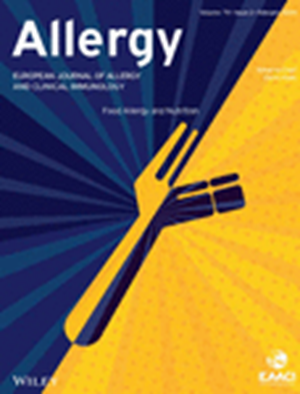A Growing Concern for Cashew and an Unexpected Risk From Almonds: Data From the Anaphylaxis Registry
IF 12.6
1区 医学
Q1 ALLERGY
引用次数: 0
Abstract
BackgroundFood allergies are a major health concern with rising prevalence. Dietary habits are changing, and information about cashew‐induced anaphylaxis is limited.MethodsCases of tree nut‐induced anaphylaxis (TIA) registered from 2007 until April 2024 were extracted from the European Anaphylaxis Registry and analyzed.Results1389 cases of TIA out of 5945 registered food‐induced reactions (23%) were identified. 1,083 cases with confirmed elicitor status, including 845 children (median age 4 years, 61% male) and 238 adults (38 years, 40% male), were selected for further analysis. The most frequent elicitors among children were cashew (对腰果的日益关注和杏仁的意外风险:来自过敏反应登记的数据
食物过敏是一个主要的健康问题,发病率越来越高。饮食习惯正在改变,关于腰果引起的过敏反应的信息有限。方法从欧洲过敏反应登记处提取2007年至2024年4月登记的树坚果致过敏反应(TIA)病例并进行分析。结果5945例登记的食物引起的TIA中有1389例(23%)被鉴定出来。1083例确认启动剂状态的病例,包括845例儿童(中位年龄4岁,61%男性)和238例成人(38岁,40%男性),用于进一步分析。儿童中最常见的刺激物是腰果(n = 334)、榛子(n = 211)和核桃(n = 146)。2007年至2024年腰果诱发的过敏反应比例有所上升,且反应多由少量(<;1茶匙)。成年人对榛子(n = 105)、核桃(n = 47)、杏仁(n = 35)和更高数量的杏仁反应频繁。50%的成人患者和17%的儿童患者存在潜在的辅助因素。反应严重程度与年龄无关,只有少数患者以前意识到自己的过敏(儿童23%,成人21%)。肾上腺素的使用在普通治疗中很低(儿童13%,成人3%),在专业治疗中达到约40%。结论腰果是一种日益增加的致过敏反应的相关过敏原,是目前儿童TIA最常见的病因。这些发现强调了采取有效预防和治疗措施的必要性。杏仁是成人中常见的诱发剂,应进一步监测。急性管理需要改进,以符合现行的指导方针。
本文章由计算机程序翻译,如有差异,请以英文原文为准。
求助全文
约1分钟内获得全文
求助全文
来源期刊

Allergy
医学-过敏
CiteScore
26.10
自引率
9.70%
发文量
393
审稿时长
2 months
期刊介绍:
Allergy is an international and multidisciplinary journal that aims to advance, impact, and communicate all aspects of the discipline of Allergy/Immunology. It publishes original articles, reviews, position papers, guidelines, editorials, news and commentaries, letters to the editors, and correspondences. The journal accepts articles based on their scientific merit and quality.
Allergy seeks to maintain contact between basic and clinical Allergy/Immunology and encourages contributions from contributors and readers from all countries. In addition to its publication, Allergy also provides abstracting and indexing information. Some of the databases that include Allergy abstracts are Abstracts on Hygiene & Communicable Disease, Academic Search Alumni Edition, AgBiotech News & Information, AGRICOLA Database, Biological Abstracts, PubMed Dietary Supplement Subset, and Global Health, among others.
 求助内容:
求助内容: 应助结果提醒方式:
应助结果提醒方式:


